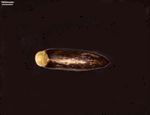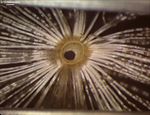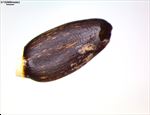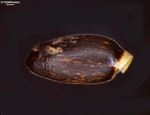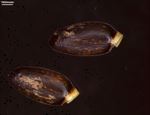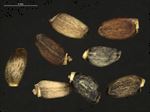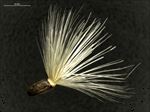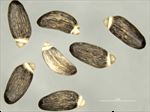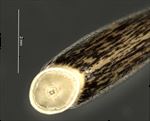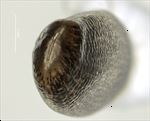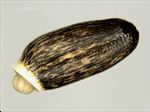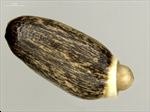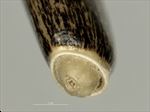Taxonomy
Silybum marianum (L.) Gaertn., Fruct. Sem. Pl. 2:378. 1791
Common synonyms
Carduus lactifolius Stokes; Carduus mariae Crantz; Carduus marianus L.; Carduus versicolor Salisb.; Carthamus maculatus (Scop.) Lam.; Centaurea dalmatica Fraas; Cirsium maculatum Scop.; Mariana lactea Hill; Mariana mariana (L.) Hill; Silybum maculatum (Scop.) Moench; Silybum mariae (Crantz) Gray; Silybum marianum var. albiflorum Eig; Silybum marianum var. marianum; Silybum pygmaeum Cass.
Common name
Blessed milk thistle
Description
Propagule or dispersal unit is the fruit with pappus. Fertile part 5.6-8 mm long, 2.5-3.5 mm wide, in side view widest in upper part (obovoid), +/- straight, the upper (apical) end narrowing, in cross-section flattened, basal scar (carpopodium) inconspicuous and undifferentiated, off to the side (oblique) or at least asymmetric, beak (=thinner sterile stalk between seed and pappus) absent, wings absent, fruit surface light brown or straw, dark brown or black, smooth (except at cellular level), with no hairs (glabrous), thickened margin absent, longitudinal ribs absent.
Pappus type bristles / hairs, pappus elements all +/- similar, up to 12-27 mm long, in several rows, pappus elements numerous, falling off as a whole, the individual bristles rough / serrated (barbellate), clearly wider at base, banded in two colours.
Ecology
Large but short-lived herb, seeds wind-dispersed. Warm-temperate to subtropical regions. Weed of pastures, croplands, various disturbed areas and wastelands, and along roads.
Native range
Mediterranean, western Asia.
Introduced range
North America, northwestern and southern South America, Europe, Ethiopia, South Africa, Afghanistan, Pakistan, China, Japan, Australia, New Zealand
